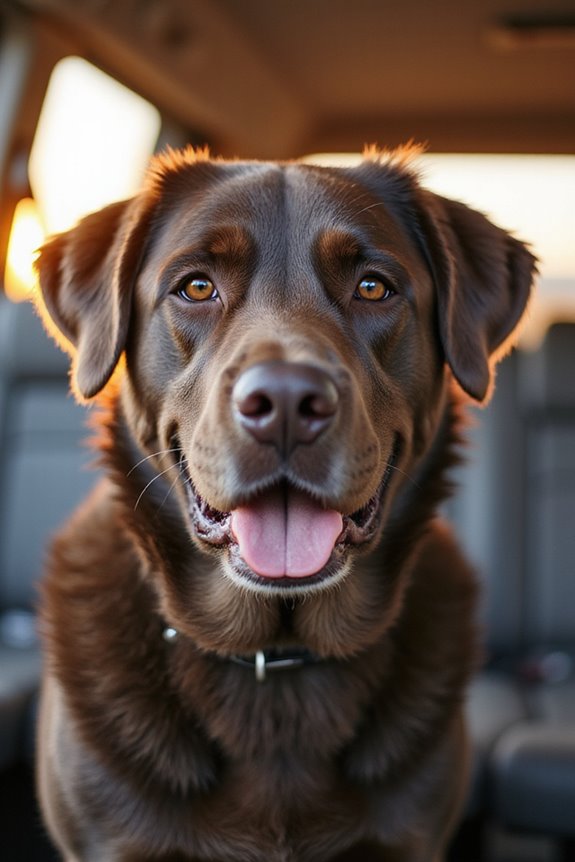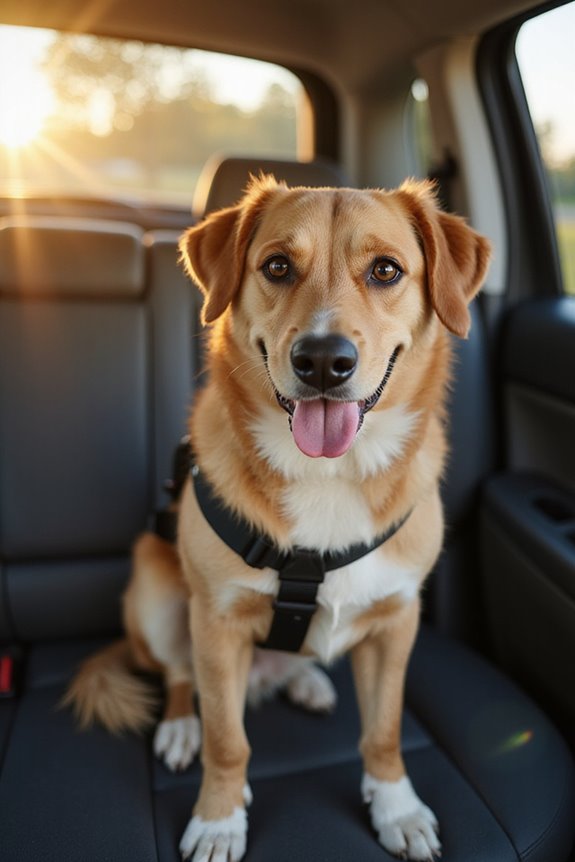To protect your dog’s paws from hot pavement, I suggest starting with gradual acclimation to hard surfaces, allowing your dog’s paws to adapt while monitoring for signs of discomfort. Schedule walks during cooler times of the day, like early morning or late evening, to avoid high temperatures. Consider applying dog-specific paw wax or moisturizer to create a protective barrier. Regularly inspect your dog’s paws for injuries or irritation, and alternate exercise options to keep them cool. There’s more to explore on this topic.
Key Takeaways
- Schedule walks for early morning or late evening when temperatures are cooler to reduce pavement heat exposure.
- Limit walks if pavement temperatures exceed 85°F to prevent paw pad burns.
- Use protective wax on paw pads regularly to create a moisture barrier against hot surfaces.
- Alternate walking locations between soft surfaces, like grass, and hard surfaces to minimize overexertion.
- Monitor your dog’s paws for signs of discomfort and inspect for injuries after each walk.
Gradual Acclimation to Hard Surfaces
When it comes to protecting your dog’s paws from the harshness of hot pavement, gradual acclimation to hard surfaces is essential. To begin this process, focus on paw pad conditioning through careful monitoring of surface exposure. Here’s how to safely acclimate your dog’s paws:
- Start during cooler hours to reduce stress.
- Begin with short walks, gradually increasing duration on hard surfaces.
- Alternate between soft and hard surfaces to prevent overexertion.
- Observe for signs of discomfort or irritation.
Protective Coverings and Moisturizers
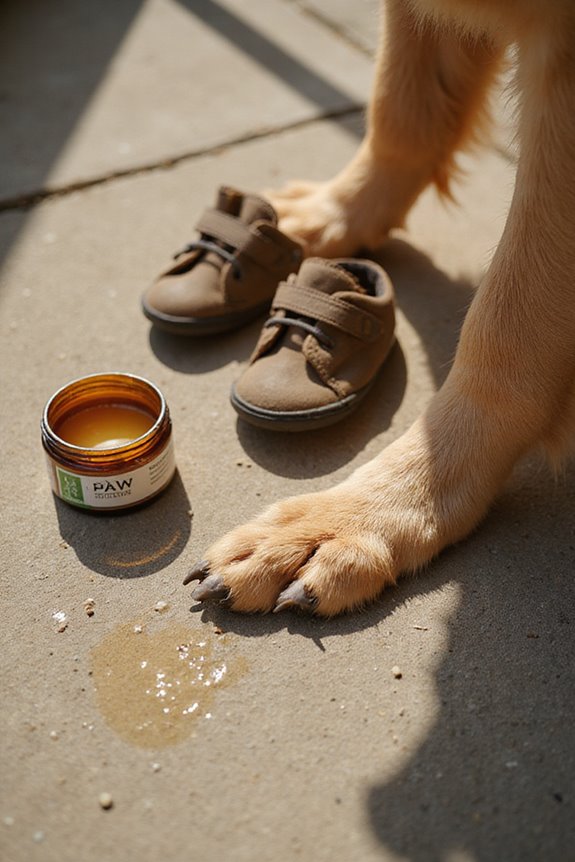
In addition to booties, regular wax application can create a protective layer on your dog’s pads, preventing burns and minimizing cracking. Choose dog-specific moisturizing products to keep the pads hydrated. Frequent application during heat spells will maintain resilience, safeguarding against harsh conditions. By combining these methods, you can greatly reduce the risk of paw injuries while enjoying outdoor adventures with your furry friend. Additionally, using products like Mushers Secret Dog Paw Wax can enhance paw protection in extreme temperatures.
Timing Walks to Avoid Peak Heat
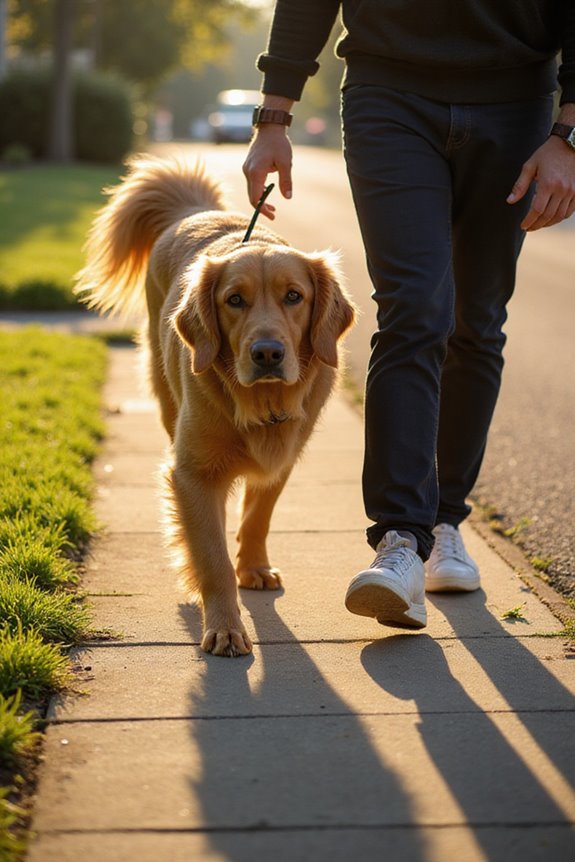
To guarantee your dog’s safety during walks, it’s essential to time them strategically, especially in warmer months. I recommend early morning or late evening walks to avoid the intensity of heat, as pavement temperatures can exceed safe levels by midday. According to temperature charts, walks should be limited or rescheduled if temperatures exceed 85°F.
Key considerations include:
- Morning Walks: Cooler air makes this an excellent option.
- Evening Walks: These provide a chance to enjoy the outdoors without the harsh sun.
- Avoiding Afternoon Walks: Their intense heat can lead to potential danger.
- Monitor Conditions: Always stay informed on weather forecasts, adapting plans per local climate variations.
These steps are essential for ensuring your dog’s safety and comfort.
Monitoring and Maintaining Paw Health
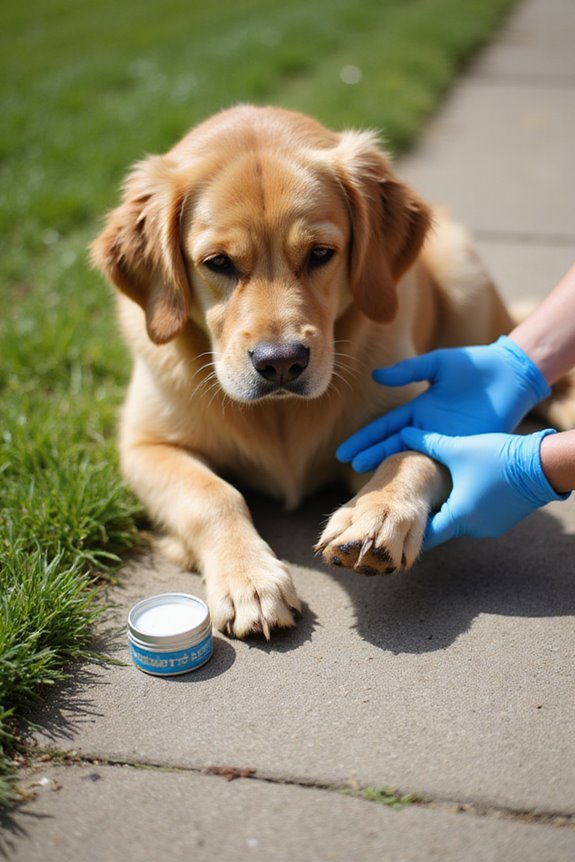
Protecting your dog’s paws is vital for their overall health, especially when faced with various environmental hazards. Regular paw inspections are important for detecting potential injury symptoms early. Here are key indicators to monitor:
- Frequent licking or chewing may signal irritation.
- Visible wounds or bleeding require prompt attention.
- Limping indicates discomfort in the affected paw.
- Look for discoloration or swelling, suggestive of infection.
- Check the skin between the toes for redness or irritation.
Maintaining paw health includes proper nail trimming and applying protective balms to keep pads moisturized. After outdoor activities, clean your dog’s paws to remove any debris. Timely vigilance can prevent serious issues and guarantee your dog’s comfort and well-being. Additionally, using lick-safe formulations can provide peace of mind for pet owners concerned about their dogs ingesting the balm.
Alternative Exercise and Cooling Options
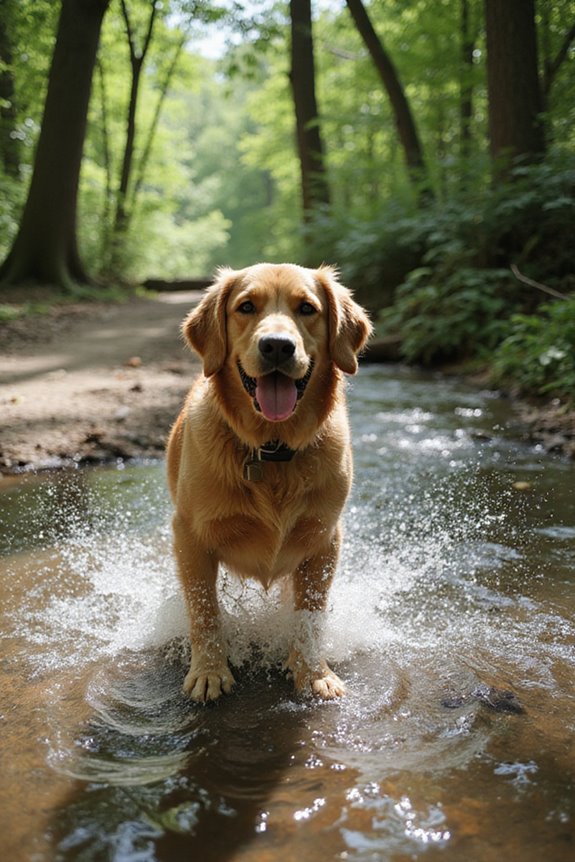
As we consider the impact of warm weather on our dogs, it’s important to explore alternative exercise and cooling options that can keep our pets comfortable and safe.
- Timing & Location:
- Schedule walks in the early morning or late evening.
- Opt for shaded parks or grassy areas, avoiding hot pavements.
- Set up a paddling pool filled with cool water in a shaded space for your dog to cool down.
- Engage your dog in swimming sessions in safe bodies of water, where a dog life jacket can ensure their safety.
- Play indoor fetch or obedience training.
- Utilize interactive toys for mental stimulation while avoiding heat exposure.
- Reddened or pink discoloration of paw pads.
- Visible injuries like missing pieces, blisters, or cracks.
- Swelling around the pads or between toes.
- Sudden stops or hesitance when walking.
- Uncontrolled panting or avoiding weight on certain legs.
These strategies guarantee your dog stays active while protecting their paws and cooling them effectively.
Practical Tests for Temperature Awareness
When considering the safety of our dogs during summer walks, it’s essential to incorporate practical tests for temperature awareness. One effective method is the seven-second hand test: place the back of your hand on the pavement for seven seconds. If it’s too hot to endure, it’s unsafe for your dog’s paws. While air temperatures might seem manageable, remember that surface materials like asphalt can exceed 140°F on hot days, posing serious burn risks. Regular temperature testing before walks can help you gauge ground conditions effectively. Also, monitoring pavement temperature charts, which categorize risks, can be invaluable for opting for safe walking times and surfaces. By staying vigilant, we guarantee our pets remain safe and comfortable during summer outings.
Recognizing Signs of Paw Damage
Recognizing signs of paw damage is vital for guaranteeing your dog’s well-being, especially after walks on hot pavement. Look for visual signs such as:
Behavioral signs often reveal discomfort too. If your dog is excessively licking, biting, or showing reluctance to walk, pay close attention. Other indicators include:
If you notice deep wounds, persistent swelling, or any systemic signs like vomiting, it’s vital to seek veterinary attention promptly. Being vigilant helps prevent serious paw injuries and guarantees your furry friend stays comfortable and happy.
Frequently Asked Questions
What Are the Symptoms of Paw Pad Heat Injuries?
I’ve noticed my pup’s paw pad redness and blister formation can signal heat injuries. If you see limping or excessive licking, it’s time to give those paws a break and check for more signs.
Can Dogs Get Burnt Paws in the Winter?
You won’t believe it, but yes, dogs can get burnt paws in winter! The cold pavement dangers are real. That’s why I always prioritize winter paw care—keeping my pup’s paws safe from harsh conditions is essential.
Are Certain Breeds More Susceptible to Paw Heat Injuries?
I’ve noticed that certain breeds really struggle with breed sensitivity and heat tolerance. Brachycephalic and thick-coated dogs, in particular, can suffer paw injuries more readily. Let’s stay vigilant for their well-being during hot weather!
How Can I Tell if My Dog’s Paw Pads Are Cracked?
Oh, the joys of paw pad care! If you spot cracked pad signs like excessive licking or difficulty walking, it’s time to get serious. Trust me, your furry friend won’t appreciate the pain.
Can I Use Baby Lotion on My Dog’s Paws?
I wouldn’t use baby lotion on my dog’s paws. It can harm their paw health. Instead, I prefer safe moisturizing options like coconut oil or specialized dog balms that keep their paws healthy and happy.


